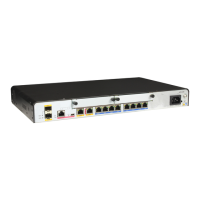outbound peer { peer-id | peer-group peer-group-name | all } bgp-label-
route { none | ip-prefix prefix-name }
To apply a policy associated with a single FEC range to an LDP peer group or all LDP
peers to which the local LSR sends Label Mapping messages, configure either the
peer-group peer-group-name or all parameter in the command.
NOTE
If multiple outbound policies are configured for a specified LDP peer, the first configured one
takes effect. For example, the following two outbound policies are configured:
outbound peer 2.2.2.2 fec host
outbound peer peer-group group1 fec none
As group1 also contains an LDP peer with peer-id of 2.2.2.2, the following outbound policy
takes effect:
outbound peer 2.2.2.2 fec host
If two outbound policies are configured in sequence and the peer parameters in the two
commands are the same, the second command overwrites the first one. For example, the
following two outbound policies are configured:
outbound peer 2.2.2.2 fec host
outbound peer 2.2.2.2 fec none
The second configuration overwrites the first one. This means that the following outbound
policy takes effect on the LDP peer with peer-id of 2.2.2.2:
outbound peer 2.2.2.2 fec none
MPLS and MPLS LDP must be enabled globally before an outbound policy is configured.
To delete all outbound policies simultaneously, run the undo outbound peer all command.
----End
2.5.10 (Optional) Configuring a Policy for Triggering LDP LSP
Establishment
A policy can be configured to allow LDP to establish LSPs based on eligible routes.
Context
After MPLS LDP is enabled, LSPs are automatically established. If no policy is configured, an
increasing number of LSPs are established, wasting resources.
A policy can be configured to allow LDP to use eligible routes to establish ingress and egress
LSPs on a public network. The policy allows only specified routes to trigger LDP LSP
establishment, controlling the number of LSPs and minimizing resource wastes.
NOTE
Do not use the lsp-trigger all command. If this command is run, all IGP routes can be used by LDP to
establish LSPs. This causes a large number of unwanted LSPs to be established, wasting system resources.
Before using the lsp-trigger all command, configure a policy for filtering out routes that LDP will not use
to establish LSPs. This reduces the number of LSPs to be established and saves system resources.
Procedure
Step 1 Run:
system-view
The system view is displayed.
Huawei AR1200 Series Enterprise Routers
Configuration Guide - MPLS 2 MPLS LDP Configuration
Issue 01 (2011-12-30) Huawei Proprietary and Confidential
Copyright © Huawei Technologies Co., Ltd.
47

